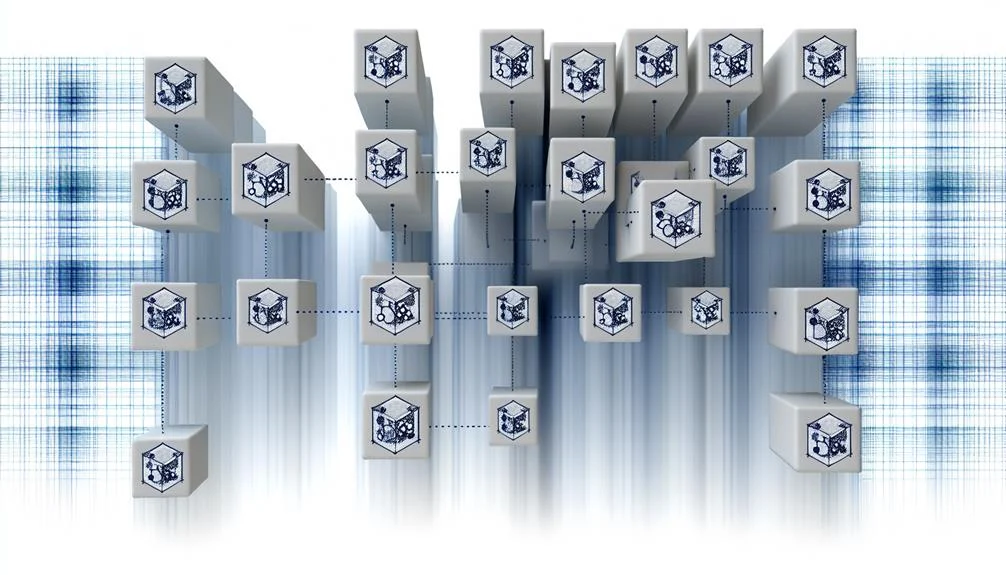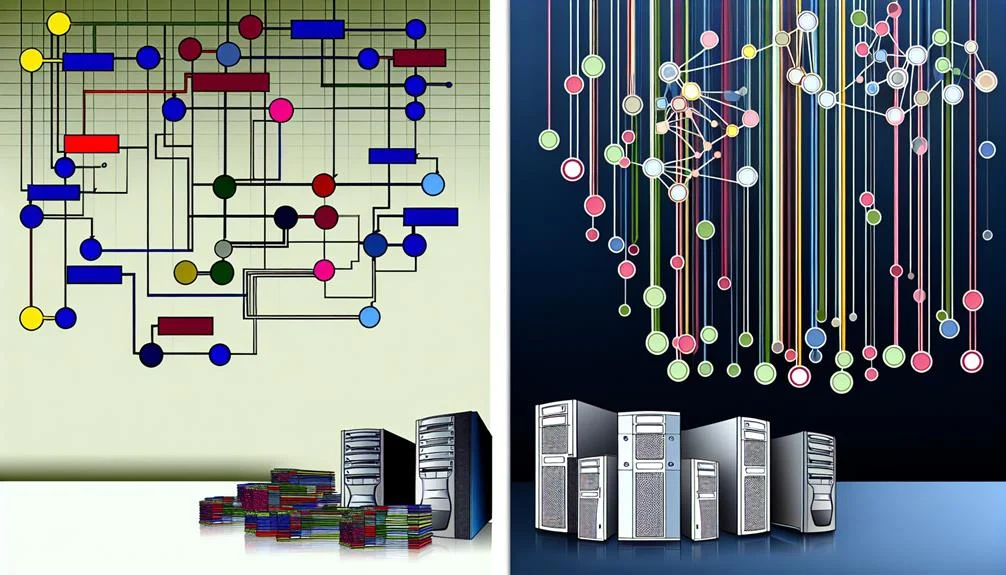In software development, understanding the different types of system design is essential for tailoring solutions that meet specific business needs and scalability requirements. Each design type offers distinct advantages and challenges, from the robust, unified structure of monolithic designs to the flexible, independent nature of microservices. Additionally, the reactivity of event-driven systems and the interoperability of service-oriented architectures provide further options for developers aiming to optimize performance and maintainability. As we explore these methodologies, one might wonder how the choice of system design impacts the overall success and efficiency of technology solutions in different environments.
Key Takeaways
- Monolithic System Design features a single, unified application with tightly coupled modules.
- Microservices System Design consists of decentralized, autonomous services enhancing scalability and fault isolation.
- Event-Driven System Design relies on events for interactions, promoting real-time responsiveness and efficient data handling.
- Service-Oriented Architecture focuses on clear service components with well-defined communication protocols for modular integration.
- Cloud-Based System Design emphasizes scalability and reliability through distributed cloud resources and collaborative environments.
The Different Types of System Design: Monolithic System
When considering monolithic system design, a single, unified application comprises interconnected components with a common codebase and tightly coupled modules. This architecture is particularly beneficial for small-scale projects due to its straightforward developmental and deployment processes.
The simplicity of a monolithic design arises from its single executable or deployable unit, which integrates all functionalities and business logic in a cohesive manner.
Despite its initial simplicity, the tightly coupled nature of modules within a monolithic codebase can pose challenges regarding maintainability as the system’s complexity increases. Each component in a monolithic system depends on others, meaning that changes in one module could potentially affect the entire application. This interdependency necessitates thorough testing and validation, which can be resource-intensive.
While monolithic systems are favored for their ease of development when dealing with less complex requirements, their scalability can become a constraint. As the application grows, the intertwined components can make it cumbersome to scale specific functionalities independently. This characteristic makes monolithic designs more suited to projects where the scope is clearly defined and is not expected to undergo significant scaling or functional diversification.
Microservices System Design

Contrasting with the tightly coupled nature of monolithic system design, Microservices System Design adopts a decentralized approach, structuring applications as a collection of small, autonomous services. In this model, each microservice functions as an independent service with its own dedicated codebase, enabling modular enhancements and maintenance.
This architectural style notably augments scalability by allowing each component to be scaled independently based on demand, without affecting the performance of other services.
Microservices architecture excels in promoting fault isolation; errors in one service do not cascade to others, thereby ensuring greater system resilience. This isolation also facilitates continuous delivery practices, as updates can be deployed to individual services without disrupting the entire system.
The autonomous nature of each microservice allows for more flexible and rapid development cycles, enhancing productivity across distributed development teams.
This design benefits the distributed systems environmentthrough improved flexibility and easier integration of heterogeneous technologies. Teams can choose the best stack for their specific service, optimizing performance and efficiency.
Ultimately, the microservices approach supports complex, large-scale system deployments and provides a robust framework for maintaining high levels of system availability and reliability.
Event-Driven System Design

Event-Driven System Design is characterized by its reliance on events to trigger and manage interactions across various system components.
By dissecting the core components of this design approach, one gains insight into its structural advantages and why it is favored in environments demanding real-time responsiveness.
The benefits of adopting an Event-Driven architecture include improved scalability, responsiveness, and a more dynamic integration of complex functionalities.
Core Components Explained
Event-driven system Design’s core functionality hinges on its ability to process and react to events in real time, which is essential for applications demanding quick response times. This system design paradigm is particularly advantageous for sectors like IoT devices and online gaming, where immediate responsiveness is pivotal. By structuring systems to manage and respond to events as they occur, event-driven architectures facilitate real-time data processing and efficient communication among system components.
The architecture of event-driven systems is inherently designed to handle high volumes of data efficiently. This is achieved through decentralized event handlers that operate independently to process incoming events. The scalability of such systems is enhanced as additional event processors can be integrated seamlessly to manage increased loads without disrupting existing operations. Moreover, the focus on event responsiveness ensures that each component within the system can react to changes or requirements dynamically, improving overall system performance.
In essence, event-driven system design excels in environments where data and events are continuously generated and require immediate processing. This approach supports robust data handling capabilities and enables systems to adapt and scale according to fluctuating demands, maintaining high performance throughout.
Benefits of Event-Driven Systems
Several vital advantages make event-driven systems highly effective for applications requiring dynamic and real-time data processing. These systems are uniquely capable of handling high volumes of data with efficient processing, enabling timely responses important in sectors like financial systems, IoT, and online gaming platforms.
Event-driven architectures are structured around detecting and handling events, allowing for seamless communication between disparate system components. This approach guarantees that each component operates independently yet cooperatively, responding to real-time inputs without the need for continuous polling. Such a design not only enhances system responsiveness but also optimizes resource utilization by activating components only when necessary.
Below is a table summarizing the key benefits of event-driven systems:
| Benefit | Relevant Applications |
|---|---|
| Real-time data processing | Financial systems, IoT devices |
| Efficient handling of volumes | Online gaming, IoT devices |
| Seamless component interaction | All event-driven applications |
| Dynamic responsiveness | Financial systems, online gaming |
Service-Oriented Architecture

Service-Oriented Architecture (SOA) emphasizes defining clear service components that can operate independently yet interact effectively. This architectural style enhances system functionality through well-defined communication protocols between services, ensuring robust data exchange and process integration.
The modular nature of SOA not only fosters service reusability but also contributes significantly to the scalability and flexibility of enterprise systems.
Defining Service Components
In Service-Oriented Architecture (SOA), defining service components is essential for ensuring that each function is modular, facilitating easier management and integration. Service components are foundational elements designed to be loosely coupled, thereby allowing them to operate independently of each other. This independence is critical as it supports the deployability and scalability of individual components without impacting the overall system’s functionality.
The architecture of SOA promotes the integration of diverse systems by standardizing communication protocols and data formats, thereby enhancing interoperability. This modular approach simplifies integration and enhances system maintenance by isolating issues to specific components, thereby not affecting the more extensive system’s operations. Additionally, the reusability of these service components contributes significantly to operational flexibility, allowing organizations to adapt to new requirements with minimal disruptions.
Scalability is another key advantage SOA offers, as components can be scaled independently based on demand. This aspect of SOA is particularly beneficial in enterprise environments where varying loads on different system parts require flexible scaling options.
Communication Between Services
Having outlined the definition and role of service components in SOA, it is pertinent to explore how these services communicate to execute complex tasks. In Service-Oriented Architecture, the communication between services is critical for the integration of systems and the seamless execution of business processes. This communication is facilitated by guaranteeing that services are loosely coupled yet capable of collaborative operation, which enhances flexibility and scalability.
Services in SOA are designed to be independently deployable, which supports reusability and aids in streamlining business processes. The technical architecture allows service components to interact through well-defined interfaces and protocols, minimizing dependencies and promoting modularity.
Here’s a concise breakdown of key aspects:
| Feature | Benefit |
|---|---|
| Loosely Coupled | Enhances flexibility and scalability |
| Independently Deployable | Facilitates reusability and streamlining processes |
| Communication Protocols | Guarantees reliable integration of systems |
This structure supports enhancing productivity and adapts dynamically to evolving business needs. Effective communication between services in SOA is foundational in realizing a system that is robust, adaptable, and primed for continuous improvement.
Benefits of Modularity
Modularity in Service-Oriented Architecture (SOA) affords numerous strategic advantages, including enhanced reusability, flexibility, and scalability of services. By structuring system design around modular services, SOA facilitates a robust framework that supports varying degrees of complexity while maintaining service independence. This architecture empowers organizations to adapt more swiftly to market changes and technological advancements without extensive system overhauls.
The benefits of implementing modularity in SOA extend to maintenance and operational efficiency. Modular services simplify the update and enhancement processes, as changes can be made to individual components without necessitating downtime for the entire system. This selective update capability reduces the risks associated with deploying new features and enhances the overall system’s stability and availability.
- Streamlined Integration: Embrace the seamless connection between diverse software applications and platforms, promoting an interconnected business environment.
- Agile Response to Change: Adapt swiftly to evolving business needs with services designed for quick reconfiguration and deployment.
- Cost-Effective Scaling: Expand or reduce services efficiently in response to demand fluctuations without significant capital investment.
In this light, the strategic implementation of modularity through SOA transforms system design into a more dynamic, resilient, and user-centric framework.
Cloud-Based System Design

Cloud-Based System Design utilizes the expansive capabilities of cloud computing to facilitate application development, offering enhanced scalability and reliability without the reliance on extensive on-premises infrastructure. This approach integrates cloud computing resources, making it a strategic choice for startups and established enterprises. The inherent flexibility of cloud-based system design allows organizations to scale resources up or down based on demand, addressing the needs of fluctuating workloads without the financial burden of maintaining a large, permanent infrastructure.
Moreover, cloud-based solutions foster a collaborative environment by enhancing accessibility across geographical boundaries. Team members can access, modify, and manage the same application data in real time, irrespective of their physical locations. This aspect is particularly beneficial for global businesses that require constant interaction among dispersed teams.
Data security is also a significant advantage of cloud-based system design. Service providers implement robust security measures that are often more advanced than what individual enterprises can afford. This security framework safeguards sensitive information while maintaining compliance with regulatory standards.
The cost-effective nature of leveraging cloud infrastructure ensures that businesses can invest more in innovation and less in maintaining hardware, making cloud-based system design a prime choice for businesses aiming to maximize efficiency and productivity.
Logical and Physical Design

While logical design provides an abstract framework of data flows and processes, physical design elaborates on the system’s specific technical requirements and operational details.
Logical design centers on abstract representations, utilizing tools such as Data Flow Diagrams (DFD) and Entity-Relationship (E-R) diagrams to model the intricate data flow, inputs, outputs, and procedures within a user-centric format. This allows stakeholders to grasp the system’s functionality without delving into the technicalities.
On the other hand, physical design translates these abstract models into concrete, actionable design specificationsessential for creating a working system. It addresses the actual input and output mechanics, hardware and software specifications, and other operational details necessary for system implementation.
- Clarity in Vision: Logical design’s abstract models provide a clear vision and understanding of system operations, fostering confidence and alignment among stakeholders.
- Precision in Execution: Physical design’s detailed focus ensures accurate and efficient execution, minimizing errors and optimizing performance.
- Seamless Integration: The shift from logical to physical design supports smooth integration, guaranteeing that the system functions as intended in real-world scenarios.
Distributed System Design

Distributed system design integrates multiple computers to process and manage data collaboratively, aiming to enhance scalability and reliability across networks. This architectural approach enables the horizontal scaling of applications by distributing workloads across various nodes. Each node operates as part of a cohesive system, yet can function independently, which enhances the system’s overall fault tolerance and high availability.
Key to this design is managing failures efficiently, which can stem from network problems, software glitches, or hardware malfunctions. The architecture must guarantee that the system remains operational and consistent despite these potential issues. This is achieved through strategies that promote fault tolerance, such as replicating data across different nodes to safeguard against data loss during a node failure.
Furthermore, distributed systems must address the challenges of consistency and partition tolerance, especially in environments dealing with big data and requiring real-time processing. Ensuring data consistency across distributed nodes while maintaining system availability, even when parts of the system are partitioned or isolated due to network failures, is critical.
This balance, often dictated by the CAP theorem, influences the choice between consistency and availability in the face of network partitions, shaping the system’s overall design and operational dynamics.
Conclusion
In the vast tapestry of system design, each architecture—monolithic, microservices, event-driven, service-oriented, cloud-based, or distributed—serves as a unique thread contributing to the overall robustness and functionality of technological frameworks.
These paradigms, with their distinct characteristics and applications, weave together to form the backbone of modern digital ecosystems. They offer tailored solutions that cater to specific operational needs while driving innovation and efficiency in an ever-evolving digital landscape.





